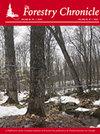Effects of copper and silver nanoparticles on growth of selected species of pathogenic and wood-decay fungi in vitro
IF 0.8
4区 农林科学
Q3 FORESTRY
引用次数: 18
Abstract
As research indicates a role for metal nanoparticles as fungicides, the work described here addresses the influence of copper nanoparticles (CuNPs) and silver nanoparticles (AgNPs) on the growth in vitro of pathogens causing damping-off as well as wood-decay fungi; i.e., Rhizoctonia solani (2 strains), Fusarium oxysporum, F. redolens and Phytophthora cactorum, along with Fistulina hepatica, Grifola frondosa, Meripilus giganteus and Sparassis crispa. Results indicate selective anti-fungal activity of the nanoparticles as applied at concentrations of 5, 15, 25 or 35 ppm. While neither nanoparticle affected P. cactorumor S. crispa, both inhibited growth in R. solani (strain 2), F. redolens and M. giganteus. R. solani (strain 1), F. oxysporum, F. hepatica and G. frondosa only showed sensitivity to higher concentrations of AgNPs, albeit with inhibitory impact on mycelial growth greater than with CuNPs. R. solani strains differed markedly in responses to both nanoparticles. Overall, the considerable toxicity of...纳米铜和银对病原真菌和木材腐朽真菌体外生长的影响
由于研究表明金属纳米颗粒作为杀菌剂的作用,本文所述的工作涉及铜纳米颗粒(CuNPs)和银纳米颗粒(AgNPs)对病原体体外生长的影响,这些病原体会导致阻尼和木材腐朽真菌;即,立枯丝核菌(2株)、尖孢镰刀菌(Fusarium oxysporum)、红曲霉(F.redolens)和仙人掌疫霉(Phytophthora cactorum),以及肝藻(Fistulina hepatica)、灰树花(Grifola frondosa。结果表明,当以5、15、25或35ppm的浓度施用时,纳米颗粒具有选择性抗真菌活性。虽然两种纳米颗粒都不影响P.cactorumor S.crispa,但都抑制了R.solani(菌株2)、F.redolens和M.giganteus的生长。R.solani(菌株1)、F.oxysporum、F.hepatica和G.frondosa仅对较高浓度的AgNPs表现出敏感性,尽管对菌丝生长的抑制作用大于CuNPs。R.solani菌株对两种纳米颗粒的反应显著不同。总的来说。。。
本文章由计算机程序翻译,如有差异,请以英文原文为准。
求助全文
约1分钟内获得全文
求助全文
来源期刊

Forestry Chronicle
农林科学-林学
CiteScore
1.20
自引率
0.00%
发文量
6
审稿时长
18-36 weeks
期刊介绍:
The Canadian Institute of Forestry has published The Forestry Chronicle, a professional and scientific forestry journal, since 1925. The Forestry Chronicle is published to provide information to forest practitioners about professional and scientific management of forests and their resources. The Forestry Chronicle provides forest practitioners in Canada and around the world with a means to communicate with their peers in the professional community.
 求助内容:
求助内容: 应助结果提醒方式:
应助结果提醒方式:


